Centers
”KARADŽIĆ” FROM LOZNICA, ONE OF THE OLDEST CULTURAL AND ARTISTIC SOCIETIES IN THE BALKANS
Forever Young
From 1850 until today, the best that Jadar has had has been woven in this village and around it. Vuk Karadžić himself also helped. The flag of this Society has been decorated with the Order of St. Sava, and it was brought before the court by Austro-Hungarians in 1915 in Banjaluka. In Vuk’s cultural center it is still boiling, ”Karadžić” gathers around five hundred members. They perform around the world, brilliantly. They dance, chant, paint, write. They know that we must always return back to tradition in a creative way. And that we are alive as much as it is
Text and photo: Nenad Marković
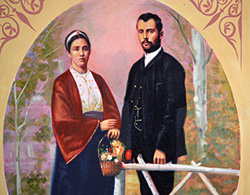 The last winter winds were blowing through the alleys of Loznica in the mid-19th century, when a group of officials of the local government and artisans gathered by priest Ignjat Vasić and prepared the first theater performance with them. On March 2, 1850, Srbske novine published the news about the formation of an ”amateur troupe” that, ”to exceptional delight of the audience”, performed the play The Battle of Kosovo and Svetislav and Mileva, and they also announced the premiere of Vladislav, the King of Bulgaria. This laid the foundations of one of the oldest cultural-artistic societies in the Balkans, ”Karadžić” from Loznica.
The last winter winds were blowing through the alleys of Loznica in the mid-19th century, when a group of officials of the local government and artisans gathered by priest Ignjat Vasić and prepared the first theater performance with them. On March 2, 1850, Srbske novine published the news about the formation of an ”amateur troupe” that, ”to exceptional delight of the audience”, performed the play The Battle of Kosovo and Svetislav and Mileva, and they also announced the premiere of Vladislav, the King of Bulgaria. This laid the foundations of one of the oldest cultural-artistic societies in the Balkans, ”Karadžić” from Loznica.
 The year 2015 was marked by the celebration of the great jubilee, and Dragan Tošić, president of the society that has around 500 members, said that it was filled with programs of all sections.
The year 2015 was marked by the celebration of the great jubilee, and Dragan Tošić, president of the society that has around 500 members, said that it was filled with programs of all sections.
– As a part of the anniversary celebration, we have organized a series of programs entitled”Karadžić” to Its City, in addition to about 150 regular annual programs. On the eve of the Day of Archangel Michael, the Patron Saint Day of Vuk Karadžić and the society, one section was being presented every day, and at the final ceremony we awarded recognitions to members and friends who support us – says Tošić. – At this time it is not easy to survive, we receive some money from the City, which is important because it allows us to work, but if we had more, we would be more productive. Thus, we try to ensure that the quality of our work is much higher than 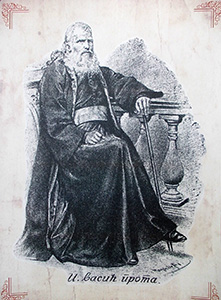 the amount we receive.
the amount we receive.
The amateur group grew into the Society of Podrinje Accord led by priest Ignat. Vuk Karadžić was pleased with this, and he discussed with his countrymen in his village the significance of cultural activities, and was also sending books. After that a library was opened, and in 1869 priest Ignat donated the land for construction of a reading room. The foundation stone was laid by King Milan, with regent Blaznavce. The priest died in 1888, and four years later the name changed into the Singing Society ”Karadžić”. After the changes in Serbia in 190, cooperation extends with educational and cultural workers from across the country, but also with societies across the Drina River, marking the beginning of a grudge toward -Hungarians in the annexed Bosnia. They tried to prevent guest performances of the society, and censored the programs.
EFFORT OF MANY GENERATIONS
 When shotguns were heard in the First Balkan War, members of the society went to war, and in 1914 Loznica was under attack by Austro-Hungarian forces seeking to punish Serbia. The time came for display of hatred against ”Karadžić”, and the occupier ransacked the members’ homes, and burned the archive and the flag of the society in the center of the city. At the high-treason process in Banjaluka in 1915, ”Karadžić” was included in the indictment: ”The task of the Loznica board was supported to a great extent by the local Cultural Society ”Karadžić”... They traveled to Brčko, Sarajevo, Tuzla and Zvornik and organized events and entertainment for the benefit of ”Prosvjet”. Documents were found according to which the
When shotguns were heard in the First Balkan War, members of the society went to war, and in 1914 Loznica was under attack by Austro-Hungarian forces seeking to punish Serbia. The time came for display of hatred against ”Karadžić”, and the occupier ransacked the members’ homes, and burned the archive and the flag of the society in the center of the city. At the high-treason process in Banjaluka in 1915, ”Karadžić” was included in the indictment: ”The task of the Loznica board was supported to a great extent by the local Cultural Society ”Karadžić”... They traveled to Brčko, Sarajevo, Tuzla and Zvornik and organized events and entertainment for the benefit of ”Prosvjet”. Documents were found according to which the 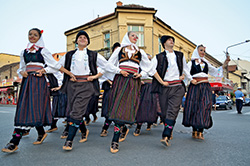 society members were changing the order in case of campaign to Bosnia to spy on the condition of the army for the National Defense...”
society members were changing the order in case of campaign to Bosnia to spy on the condition of the army for the National Defense...”
Many members did not return from the Great War, but the work was restored and the name is changed to Educational Society ”Karadžić” in Loznica. In early 1933, the Assembly of the society adopted the work program which puts in the foreground the restoration of Vuk’s house in Tršić and establishment of Vuk’s Assembly. That year, on Sunday before the Nativity of the Virgin, Vuk’s house was consecrated and the first Assembly took place. Then preparations began for the building of Vuk’s cultural center in Loznica. It was designed by Belgrade architect Franjo Urban, and the land on which it was built was donated by Pavle and Staka Pejić, merchants from Lešnica. On St. Demetrius Day  in 1937, marking the 150th anniversary of Vuk’s birth, the building was handed over to the society, and academician Aleksandar Belić emphasized the contribution of ”Karadžić” to fostering and disseminating the thoughts of liberation.
in 1937, marking the 150th anniversary of Vuk’s birth, the building was handed over to the society, and academician Aleksandar Belić emphasized the contribution of ”Karadžić” to fostering and disseminating the thoughts of liberation.
The Second World War interrupted their work, the German soldiers desecrated the temple of culture, but in September 1944 the liberators entered the city and the society was once again restored. The liberation brings new name, Cultural-Artistic Society ”Karadžić”, sections and programs multiply, and they also start going on tours abroad. Performances around the world come one after the other, warming the palms of audiences in Japan, Australia, Algeria and throughout Europe, from Portugal to Russia.
APPROACH AND QUALITY ARE NOT THOSE OF AMATEURS
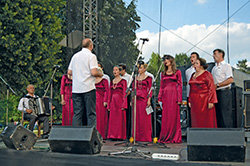 After 165 years, the society is still young, because it was joined by a new generation. Tošić said that the greatest interest is in folklore section, but also for the group of singers and theater.
After 165 years, the society is still young, because it was joined by a new generation. Tošić said that the greatest interest is in folklore section, but also for the group of singers and theater.
– Alchemists are searching for the elixir of youth, and we seem to have found it. New generations keep coming, with new talents and ideas, and it is the main strength of ”Karadžić”. We are grateful to those who came before us and those who will come and be even better. To some extent, we also perform educational function, because our young members spend their time better. It is great to enter Vuk’s cultural center and see how everything is bustling with children going to sections and rehearsals. I am p copy.jpg) roud that there is no vice among them, and that was proved last year when we were stopped by the police before Munich, travelling as guests of the local Cultural Society ”Saint Sava”. They searched every pocket, every piece of luggage and even took off upholstery from the bus seats and found nothing. It showed what our children were like. The future of ”Karadžić” is on them – says Tošić.
roud that there is no vice among them, and that was proved last year when we were stopped by the police before Munich, travelling as guests of the local Cultural Society ”Saint Sava”. They searched every pocket, every piece of luggage and even took off upholstery from the bus seats and found nothing. It showed what our children were like. The future of ”Karadžić” is on them – says Tošić.
The society consists of folklore ensemble, from children to veterans, theater, folk orchestra, a group of singers, literary club, art group and gusle section. They organize numerous events, from the Acting Festival to literary and gusle evenings. According to  Tošić, ”Karadžić” includes everybody who is engaged in culture in Loznica in a creative way. It is one of the few societies that have a folk ensemble, as well as painters, writers, and actors... He particularly emphasizes that amateur societies, in his opinion, often have more professional performances than those who do it as a job, and productions performed by professionals are often less satisfying in terms of artistic criteria.
Tošić, ”Karadžić” includes everybody who is engaged in culture in Loznica in a creative way. It is one of the few societies that have a folk ensemble, as well as painters, writers, and actors... He particularly emphasizes that amateur societies, in his opinion, often have more professional performances than those who do it as a job, and productions performed by professionals are often less satisfying in terms of artistic criteria.
– We don’t make a living by doing this, but have a very professional 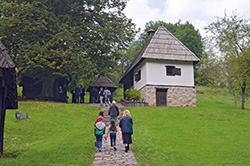 attitude towards it. The fact that we are amateurs does not mean that we are amateurs also on the stage – says Tošić.
attitude towards it. The fact that we are amateurs does not mean that we are amateurs also on the stage – says Tošić.
Showcases of the society are filled with recognitions, the Medal of Merit for the People, the September Award of the City of Loznica and Vuk's Award to plaques from foreign cities. The showcase also displays a Japanese traditional costume, obtained on tour in Japan, as well as numerous trophies and plaques.
***
The Flag
Zoran Grujić, the Secretary of ”Karadžić”, says that in 1897 General Mihajlo Bogicević, descendant of Duke Ante from Loznica, donated the flag to this society that was later burned by Austro-Hungarians.
– It used to be carried all over Serbia and Bosnia and was decorated in 1908 as a symbol of enlightenment thought with the Order of St. Sava of the fifth row. In early 1931, ”Karadžić” received a new flag from Borisav Ristić, a merchant from Belgrade, originally from Loznica, and it is still here with us – says Grujić, pointing to a more than eight decades old flag.
***
The Japanese
The former choreographer of ”Karadžić” Miodrag Spernjak, now deceased, was in 2005 in Fukuyama, Japan, where he held a seminar for more than 120 participants. As the first Serb who does this, he showed them how to play kolo dance from Jadar and Serbia, as well as the old town dances. This was reported in the local newspapers printed in millions of copies.
***
Horse Stalls
In 1941, the Germans turned Vuk’s home into stables, and after the liberation its original purpose was restored. At one point, shortly after the war, some of the representatives of the new authorities threatened to give it back this role. There were those who wanted to replace ”Karadžić”, with the newly established society ”Abrašević”, or at least to move some sections under its wing. On one side of the building there was an inscription with the name of the new society, on the other side with the old name, and there were disputes over the use of the premises. However, there were more prominent citizens in ”Karadžić”and the society survived this temptation as well.
